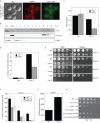A stress-responsive system for mitochondrial protein degradation
- PMID: 21070972
- PMCID: PMC2998070
- DOI: 10.1016/j.molcel.2010.10.021
A stress-responsive system for mitochondrial protein degradation
Abstract
We show that Ydr049 (renamed VCP/Cdc48-associated mitochondrial stress-responsive--Vms1), a member of an unstudied pan-eukaryotic protein family, translocates from the cytosol to mitochondria upon mitochondrial stress. Cells lacking Vms1 show progressive mitochondrial failure, hypersensitivity to oxidative stress, and decreased chronological life span. Both yeast and mammalian Vms1 stably interact with Cdc48/VCP/p97, a component of the ubiquitin/proteasome system with a well-defined role in endoplasmic reticulum-associated protein degradation (ERAD), wherein misfolded ER proteins are degraded in the cytosol. We show that oxidative stress triggers mitochondrial localization of Cdc48 and this is dependent on Vms1. When this system is impaired by mutation of Vms1, ubiquitin-dependent mitochondrial protein degradation, mitochondrial respiratory function, and cell viability are compromised. We demonstrate that Vms1 is a required component of an evolutionarily conserved system for mitochondrial protein degradation, which is necessary to maintain mitochondrial, cellular, and organismal viability.
Copyright © 2010 Elsevier Inc. All rights reserved.
Figures







Comment in
-
Stressed-out mitochondria get MAD.Cell Metab. 2010 Dec 1;12(6):559-60. doi: 10.1016/j.cmet.2010.11.018. Cell Metab. 2010. PMID: 21109188 Free PMC article.
Similar articles
-
Intramolecular interactions control Vms1 translocation to damaged mitochondria.Mol Biol Cell. 2013 May;24(9):1263-73. doi: 10.1091/mbc.E13-02-0072. Epub 2013 Mar 6. Mol Biol Cell. 2013. PMID: 23468520 Free PMC article.
-
Mitochondrial quality control by the ubiquitin-proteasome system.Biochem Soc Trans. 2011 Oct;39(5):1509-13. doi: 10.1042/BST0391509. Biochem Soc Trans. 2011. PMID: 21936843 Review.
-
The Cdc48-Vms1 complex maintains 26S proteasome architecture.Biochem J. 2014 Mar 15;458(3):459-67. doi: 10.1042/BJ20131161. Biochem J. 2014. PMID: 24351022 Free PMC article.
-
The requirement for Cdc48/p97 in nuclear protein quality control degradation depends on the substrate and correlates with substrate insolubility.J Cell Sci. 2014 May 1;127(Pt 9):1980-91. doi: 10.1242/jcs.141838. Epub 2014 Feb 25. J Cell Sci. 2014. PMID: 24569878 Free PMC article.
-
Mitochondrial Surveillance by Cdc48/p97: MAD vs. Membrane Fusion.Int J Mol Sci. 2020 Sep 18;21(18):6841. doi: 10.3390/ijms21186841. Int J Mol Sci. 2020. PMID: 32961852 Free PMC article. Review.
Cited by
-
Intramolecular interactions control Vms1 translocation to damaged mitochondria.Mol Biol Cell. 2013 May;24(9):1263-73. doi: 10.1091/mbc.E13-02-0072. Epub 2013 Mar 6. Mol Biol Cell. 2013. PMID: 23468520 Free PMC article.
-
Cdc48-associated complex bound to 60S particles is required for the clearance of aberrant translation products.Proc Natl Acad Sci U S A. 2013 Mar 26;110(13):5046-51. doi: 10.1073/pnas.1221724110. Epub 2013 Mar 11. Proc Natl Acad Sci U S A. 2013. PMID: 23479637 Free PMC article.
-
Molecular Determinants of Mitochondrial Shape and Function and Their Role in Glaucoma.Antioxid Redox Signal. 2023 May;38(13-15):896-919. doi: 10.1089/ars.2022.0124. Epub 2023 Jan 5. Antioxid Redox Signal. 2023. PMID: 36301938 Free PMC article. Review.
-
Proteolytic Control of Lipid Metabolism.ACS Chem Biol. 2019 Nov 15;14(11):2406-2423. doi: 10.1021/acschembio.9b00695. Epub 2019 Sep 30. ACS Chem Biol. 2019. PMID: 31503446 Free PMC article. Review.
-
Inhibition of ATR Reverses a Mitochondrial Respiratory Insufficiency.Cells. 2022 May 24;11(11):1731. doi: 10.3390/cells11111731. Cells. 2022. PMID: 35681427 Free PMC article.
References
-
- Bays NW, Hampton RY. Cdc48-Ufd1-Npl4: stuck in the middle with Ub. Curr Biol. 2002;12:R366–371. - PubMed
Publication types
MeSH terms
Substances
Grants and funding
LinkOut - more resources
Full Text Sources
Other Literature Sources
Molecular Biology Databases
Research Materials
Miscellaneous

